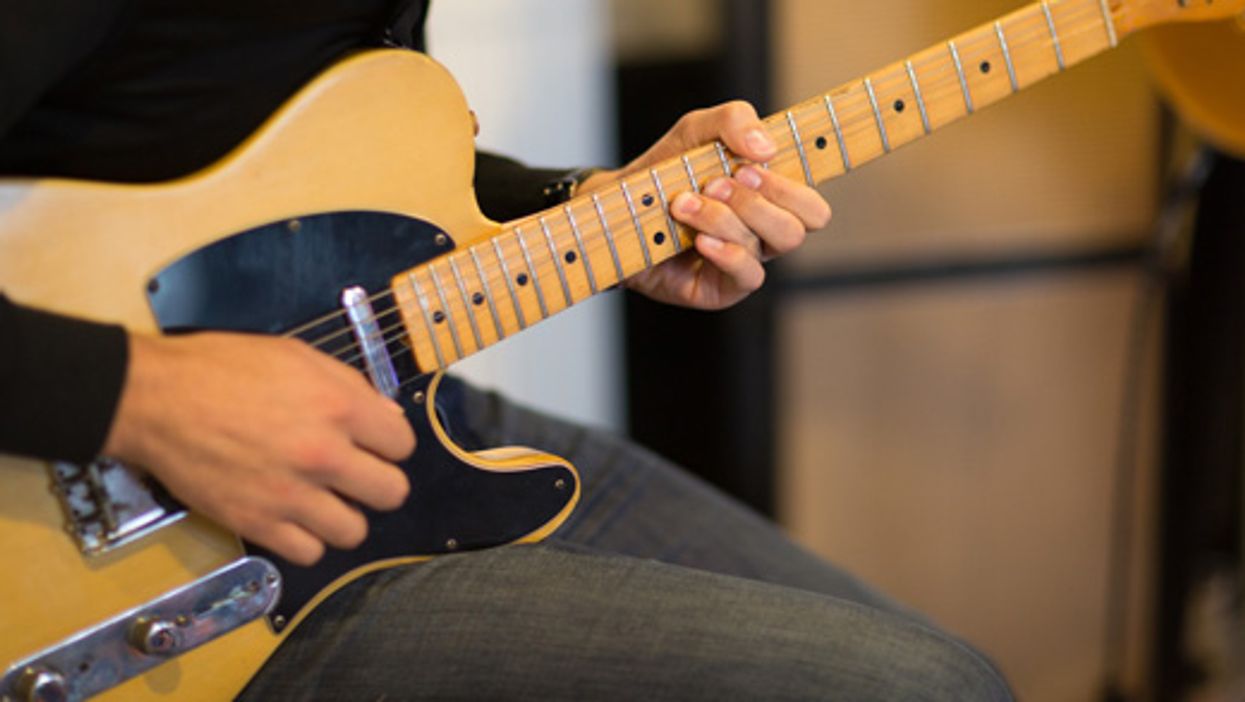Chops: Intermediate
Theory: Intermediate
Lesson Overview:
• Develop a call-and-response approach to soloing over a 12-bar blues.
• Outline the changes of a blues in the style of Grant Green, Kenny Burrell, and Ed Bickert.
• Learn how to anticipate a chord change with both single-note lines and half-step chord approaches.
Click here to download a printable PDF of this lesson's notation.
There are a lot of good reasons to incorporate chord hits into your soloing. For one thing, they help to fill in the groove and the harmonic landscape when you’re playing with just bass and drums. For another, they can reference the call-and-response sound of playing with a horn section or keyboardist. Finally, and maybe most usefully, by operating like cones on a race course, playing chord hits forces you to create and play well-defined phrases, which gives your solos clarity and momentum. In this lesson, we’ll go through several different ways to add chord hits to a mid-tempo blues in Bb.
Our first move is to play chord hits on the way into the downbeat, then answer with single-note licks. In Ex. 1, we start out by approaching the 3 and b7 (also known as a tritone) of the I chord, Bb, from a half-step below. The syncopation of playing on “4 and” creates room to answer with a single note lick after the downbeat. We repeat this half-step move on the way into measure 3, then use a similar half-step move to get into the Eb7 chord just before measure 5. You could carry this process through the rest of the 12-bar progression, as well.
Click here for Ex. 1
Alternatively, we could play single-note licks into the downbeat, as in Ex. 2, and use chord hits for the post-downbeat replies. This time, instead of just the chord’s 3 and b7, we’re using 9th-chord voicings. There’s a horn section vibe to the way the voicings shift from Bb7 to Eb7 (I to IV) and in the use of half-step motion on beat 4 when the progression returns to Bb7, the I.
Click here for Ex. 2
Let’s see how this second idea—licks followed by chord hits—works over a whole 12-bar solo. Groove-wise, Ex. 3 is more in the vein of an organ trio. The triple-stop answers are the kind of thing Hammond B-3 wizard Jimmy Smith uses on tunes like “Midnight Special” and “Back at the Chicken Shack.”
On the I chord, we’re hammering on from b3 to 3 on the 3rd string, barring with the ring finger to imply the IV chord and then repeating the hammer-on move to the I. On the IV chord, we start out with the top three strings of an Eb9 voicing, then use our ring finger to play the same shape up two frets to imply an Eb6 sound. Notice there are no chord hits over bars 9 and10 (F7 and Eb7); blowing straight through the turnaround with single-note soloing provides a release from the preceding rhythmic pattern, and the contrast gives the solo a kind of AAB structure that feels satisfying and conclusive. (Note: We’re not counting the pickup measure as measure 1. Rather, we’re numbering measures in the 12-bar form itself, which means measure 1 falls under the initial Bb7.)
Click here for Ex. 3
In Ex. 4, we’re back to using chord hits before the downbeat and single notes after, but here we’re taking more of a swing approach, choosing voicings that will spell out the transition from one chord change to the next. Heading into the first downbeat, we’re half-stepping into Bb13 from above (B13). It’s a classic move that you could also analyze as resolving from an altered V chord (F7#9) to I. We repeat that move at the end of measure 2 and at the end of measure 10. At the end of measure 4, the altered chord, Bb7b13, resolves to Eb9. In measure 6, Bbº7 resolves to Bb13, and in measure 8, we’ve got another half-step approach, from bVI (Gb9) to V (F9).
Click here for Ex. 4
Finally, in Ex. 5 we make room for some longer solo lines by concentrating the chord hits at the end of every line—in measures 3-4, 7-8, and 11-12. At the same time, we’re applying the swing aesthetic of outlining chord transitions to a jazz-blues progression that includes the I-VI-IIm-V changes. The cool four-note Bb13 and F7b13 voicings in measures 11-12 are straight out of Tele-wielding jazzer Ed Bickert’s vocabulary. Whether you want to take this idea further into a jazz direction, or just swipe some ideas to bring back into your blues, he’s the cat for that.
Click here for Ex. 5
Any one of these five approaches can work as a structured way to open a solo, a great way to climax it, or an effective way to mix things up in the middle. The more you work with chord hits and get comfortable grabbing them on the fly, the more you’ll find yourself mixing and matching these approaches and working out new ideas of your own.



















